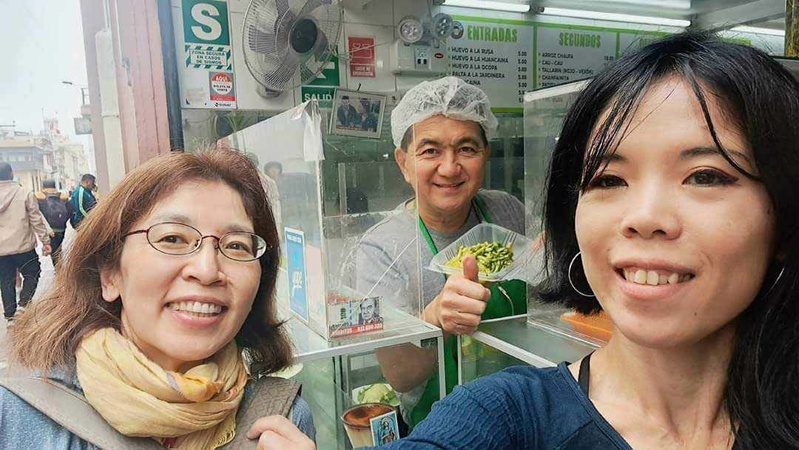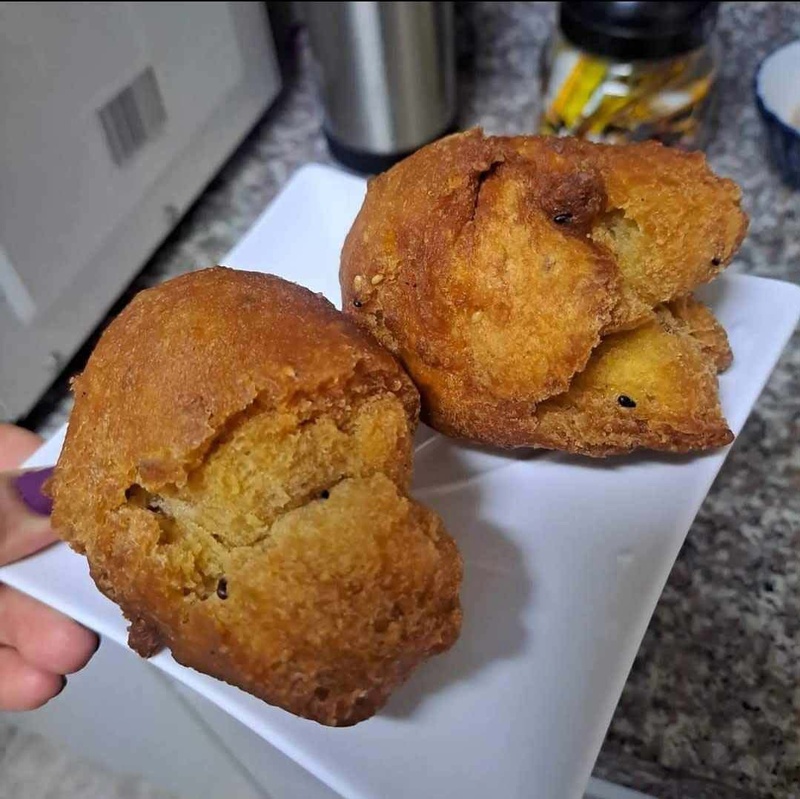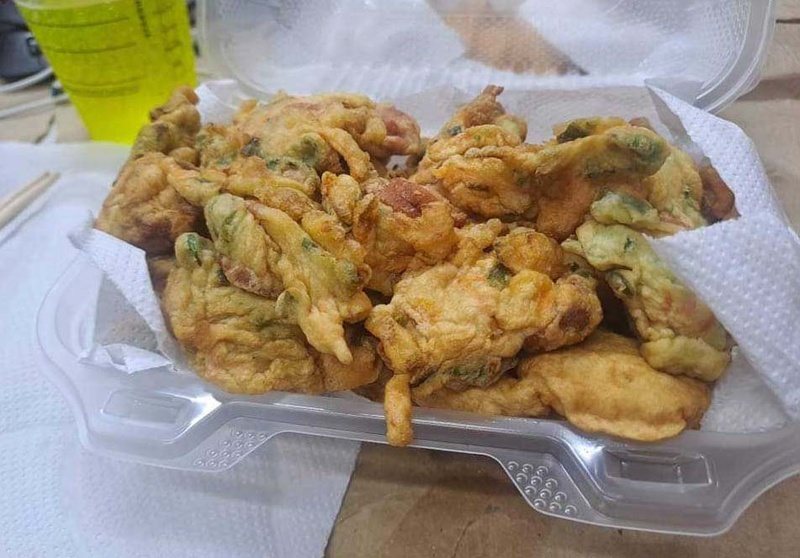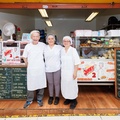“What is Nikkei cuisine?” seems like a simple question, but beneath it is a complex definition that is even hard for Nikkei themselve to describe.
Ayumi Takenaka is a Japanese sociologist with a strong interest in Nikkei cuisine in Peru. For 10 years, Dr. Takenaka has interviewed the leading exemplars of Nikkei cuisine, attended numerous culinary fairs featuring Nikkei and Peruvian food, explored the Nikkei menus of gourmet restaurants in Peru, the United States, Spain, and Great Britain, and has traveled constantly to Peru, all with the goal of answering that initial question: What is Nikkei cuisine?
During her most recent visit to Peru, Dr. Ayumi Takenaka spoke with Peru Shimpo, in between gathering information and interviewing people in Lima.
* * * * *
RESEARCH PROJECT
What is the subject of your research?
The history of Nikkei cuisine in Peru.
When did your research begin?
About 10 years ago. But at first I was studying immigration and diaspora, not Nikkei cuisine. I actually didn’t have any interest in or knowledge about Peruvian food until I visited Peru for the first time in 1996.
On that trip, I was doing research on Japanese immigration and the Nikkei community, when I realized it had a lot to do with food.
How was food important to your research on immigration?
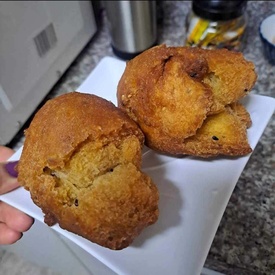
Because food is something tangible that you can directly see, touch, eat, and feel. For people it is much easier to express their experiences, their personal history, their identity, and their emotions through food.
When I interviewed Peruvian immigrants, the subject of food always came up, along with nostalgia about home cooking. I started thinking about the meaning of food.
Why did you focus on Nikkei cuisine?
About 10 years ago I was in New York and London and there was a lot of talk about Peruvian cuisine, and Nikkei cuisine had become trendy.
Gourmet Peruvian restaurants outside Peru always include Nikkei dishes such as Nikkei causa (potato dish), Nikkei ceviche, Nikkei maki and Nikkei tacu tacu (rice and beans) on their menus. I liked it and it sparked my curiosity even more.
Why did you choose Peru?
For several reasons, including the dekasegi phenomenon.
I had met some Peruvians, mostly Nikkei, who worked in Japan as dekasegi. I was really interested in studying the flow of dekasegi to Japan, but first I had to learn about the history of immigration.
That’s when I decided to travel to Peru, where I ate Peruvian food and Nikkei food for the first time.
Other factors include the Nikkei population, which is larger in Peru, and the language, because I already spoke Spanish. I learned it in Mexico and Spain.
Is there a publication date for the study?
Since I’m gathering information and working on several projects at the same time, including the Nikkei cuisine project, I don’t have an exact date.
While I have published some articles, my goal is to publish a book on the history of Nikkei cuisine. Hopefully that will happen in the next couple of years.
DEFINING NIKKEI CUISINE
How do you define Nikkei cuisine?
It is said that Nikkei cuisine is basically a fusion of Peruvian cuisine and Japanese cuisine. But there are actually different definitions and they’re all valid, since it depends on the person and their motivations. In addition to Nikkei families and chefs, there are other players on the scene, such as non-Nikkei chefs, culinary experts, food writers, and the governments of Peru and Japan, which have their own definitions, as well as the Nikkei community and its institutions and activities, such as APJ (Japanese-Peruvian Association), Gochisō, etc. There are various factors and players with their own interests.

One subject that I am interested in learning about is how these different players came up with their definitions.
What is your opinion of Nikkei cuisine?
I like it. I love it. I think of it as Peruvian food with a Japanese touch. It’s a bit more flavorful, more seasoned, with ají (hot pepper) and sauces. I like spicy food.
What about Peruvian food?

In general I like it, although the flavors can be somewhat strong and some dishes are more difficult to digest.
Is Nikkei cuisine in Peru different from or similar to Japanese food?
It’s very different. It’s not the same, although it’s also difficult to define what Japanese cuisine is since there is a lot of variety. Nikkei cuisine is different from what we’re used to in Japan but I like both versions.
Maki with ceviche sauce is a different version of Japanese sushi, but it’s an interesting version that is also delicious.
Have you visited other Latin American countries besides Peru?
I’ve been to Mexico five times, twice to Venezuela, and also to Chile and Costa Rica.
Does each country have its own version of Nikkei cuisine?
Yes. For example, you won’t find ceviche sauce in Brazil and teriyaki is much more popular in the United States. Each version uses local ingredients and they are combined in different ways, but every version has shoyu (soy sauce), ohashi (chopsticks) and gohan (rice). Another similarity would be the use of terms. There are some differences too, but I don’t have enough information yet to answer this question definitively.
Is there a version that is more similar to Japanese cuisine?
I have found that “Japanese American” or “JA” food in the United States is more similar to Japanese cuisine than Nikkei cuisine, because the United States is more culturally influential in Japan.
Nikkei cuisine in the United States, or “JA,” mostly uses teriyaki or sugar and soy-based sauce for vegetables and fish, and they even call that Nikkei food.
Peruvian food, on the other hand, has less in common with traditional Japanese food, since Peru is a country that is culturally and geographically further from Japan. So it’s a combination of two opposing cultures. This is what makes it interesting.
So, the United States is the birthplace of Nikkei food?
It seems to me that the concept of Nikkei cuisine originated here in Peru, since in the rest of the world, Nikkei cuisine is considered the fusion of Japanese and Peruvian cuisine, not “Japanese cuisine and American cuisine” or “Japanese cuisine and Mexican cuisine.”
THE CASE OF CHIFA
Chifa is considered something uniquely Peruvian, even though it’s Chinese in origin. Do you think the same could happen with Nikkei cuisine?

I think this is already happening, that Nikkei cuisine is moving away from the concept of Japanese cuisine and is part of Peruvian gastronomy.
Cuisine is always evolving, just like Japanese cuisine, which you can see in maki, for example. Change is a normal process.
There is talk of a “boom in Nikkei cuisine. Why didn’t the same thing happen with chifa?
I think it has to do with the status and image that are promoted, among other factors. One theory is that Japanese cuisine sells an image of healthy food and has a long history in the global gourmet market.
If the concept of Nikkei cuisine is still vague for Nikkeis, what reference do foreign chefs have for cooking Nikkei dishes?
They understand Nikkei cuisine as the fusion of Japanese cuisine and Peruvian cuisine, and that’s the reference.
I think this is due in large part to the popularity of Peruvian cuisine abroad and the promotion of Nikkei cuisine as part of Peruvian cuisine, and the increase in the number of Peruvian restaurants abroad that include Nikkei cuisine in their menus.
Is “Nikkei cuisine” different from “the food that Nikkei eat?”
That also depends on how each concept is defined. Gourmet Nikkei cuisine is what is known abroad, not homemade Nikkei food.
For example, a Nikkei dish in an elegant restaurant costs 20 dollars and that dish has nothing to do with what the first Japanese immigrants to Peru ate. I asked myself, “Are Nikkei homes the origins of Nikkei cuisine?”

This is another question that I hope to address in this research.
Is there any Nikkei food that you don’t like?
I like everything, but if I have to choose something it would be a maki that had too much mayonnaise. I bought it from a fast-food stand at a mall. That was five years ago.
And what do you like the most?
My favorite dish is tacu tacu (rice and beans). I also like olluquito (a dish with ulluki, a root vegetable) and dishes made with yellow potatoes, which are ingredients we don’t have in Japan, or at least I haven’t tried them there.
HER VISIT TO PERU
What was your first trip to Peru like?
It was in 1996. I came alone and I already knew the language, but I didn’t know anyone or have any contacts in Peru. The first people I met were through some friends in Japan. When I traveled to Peru, I was in a PhD program at Columbia University.
How long have your visits to Peru been?
I’ve come to Peru several times for two to three months, but the longest stay was six months, which was when I came the first time.
What do you find most problematic about Peru?
Getting around. This time it hasn’t been so easy to get around, to go any place at any time. The public transport sytsem isn’t very efficient. I can’t just take any taxi and I can’t go to downtown Lima alone.
And all of that is related to another problem, which is safety.
I remember that I was mugged the first time I came to Peru. There was an important soccer game that day and I walked right by a group of rowdy fans and they robbed me. And the last time I went to Gamarra [a neighborhood in Lima] I went with two friends, a Nikkei friend and a non-Nikkei friend. They carried a baseball bat and I walked between them. I travel around alone for my research and there are places in Lima where I don’t feel safe. But, despite this difficulty, I’ve had pleasant experiences and that’s why I keep coming to Peru.
Do you like the Spanish language?
Yes, I like it very, very, very much. I’ve always been interested in the Spanish language and Latin American culture.
I’ve been to Mexico five times, spending three months in Tijuana and a month in Guanajuato, and five times to Spain, where I stayed for six months.
The reason for traveling to those countries was first to study the language and then for research, conferences, and visits.
I learned to speak Spanish in Mexico and Spain, before coming to Peru in 1996.
* * * * *
ARE THEY CALLED OKASHI?

One of the best-known Nikkei culinary terms is “okashi.”
During the interview, Dr. Takenaka was holding a box of Japanese sweets, such as daifuku mochi, dorayaki and other delicious “okashi,” as we Nikkei call them.
But what she first noticed about them was the name. “In Japan, we don’t say okashi.”
For the Nikkei, okashi refers to traditional Japanese sweets, but in Japan they are known as wagashi.
Wagashi are made from natural, non-animal based ingredients (they don’t contain milk) and they are made fresh, without preservatives. But those are precisely the characteristics of the Nikkei okashi.
“I have never seen Nikkei okashi in Japan. I think we would cal it Nikkei wagashi,” she said as we wrapped up.

* * * * *
AYUMI TAKENAKA
Ayumi Takenaka is a Japanese sociologist who earned her PhD from Columbia University (United States) who studies topics related to immigration, diaspora, and cuisine, with a particular emphasis on Peru. She is currently a professor in the Department of Social Sciences at Hitotsubashi University in Japan. She speaks Spanish and English, as well as her native language, Japanese.
Dr. Ayumi Takenaka focuses on the Latino ethnic group and above all, on the Peruvian community, due to its presence in different countries.
*This article was originally published in the Peru Shimpo newspaper, printed edition, on August 13, 2023.
© 2023 Milagros Tsukayama Shinzato


